2022 Facility Of The Year Overall Winner: Home Team Storage, Galveston, Texas
With miles of sun-kissed beaches, a treasure trove of alluring attractions, and countless opportunities for outdoor recreation, Texas’ historic island city of Galveston is a seaside paradise for its 53,000-plus residents and tourists alike. From various museums, sightseeing tours, parks, and piers to fine dining, shopping, and historical architecture, there is something for everyone to enjoy. And for those needing storage space, there’s a brand-new facility that’s just as appealing as Galveston’s Southern charm and temperate weather.
Home Team Storage is a three-story, 100,095-square-foot facility located on a main thoroughfare in Galveston, Texas, in close proximity to two popular tourist destinations, Moody Gardens and Schlitterbahn Waterpark. Although it’s a standout establishment on the island, the development of Home Team Storage was anything but smooth sailing. After overcoming major obstacles and lengthy delays, the 599-unit property opened its doors in September of 2021. A little over a year later, its contemporary architecture, supreme setting, and numerous construction challenges have earned it the title of Mini-Storage Messenger’s 2022 Overall Facility of the Year winner.
An Ideal Site
Before the pandemic took hold of the nation, Scenic Capital Advisors, a privately held real estate investment firm that acquires, develops, and manages commercial real estate, had located a 1.584-acre lot in Galveston that the company felt would be perfect for an institutional-grade self-storage facility. They had already constructed two such facilities in Texas and were ready to expand their portfolio with a third.
This “ideal site” is on Stewart Road, a major street that unites the east and west sides of the island. While Stewart Road is home to mostly commercial establishments, it’s also conveniently located near several residential neighborhoods. At the time, the market area was lacking climate-controlled storage options, which is a highly sought-after feature due to Galveston’s above-average humidity. In fact, there were only five climate-controlled self-storage facilities on the island prior to the construction of the Home Team Storage property.
Clearly, there was demand for climate-controlled storage, but providing a new, dry supply of storage space to the market wouldn’t be easy. This particular parcel, along with the neighboring areas, are at an elevation of 11 feet, thus placing it in a FEMA AE flood zone with a one percent chance of flooding on an annual basis. Since most of Galveston is barely above sea level, and the island is frequently battered by hurricanes, Scenic Capital needed to ensure the protection of its future tenants’ belongings from potentially damaging storms in order to make the site feasible for self-storage.
Despite the additional costs required to develop the property up to code, Scenic Capital knew the investment would be rewarding in the end. Therefore, the company hired Capco General Contracting to elevate the site above the flood plain and oversee the construction of their vision: a three-story, climate-controlled, mixed-use self-storage facility that would benefit its surrounding areas.
Parcel Problems
Though the plot was of ample size for the intended project, it sloped four feet from front to back, making it difficult to fit a facility larger than 100,000 square feet onto the parcel. Moreover, site modifications were necessary due to its location within an area of extreme flooding (FEMA AE). Per mandates from the city, the facility’s ground floor would need to be at least two feet above the flood plain.
To correct the slope and raise the foundation, it was essential to increase the height by seven feet on one side of the property and four feet on the other. Additionally, the rear side of the site had to be raised by six feet to mitigate the grade change. These dramatic elevations required that retaining walls be built around three of the property’s four sides to protect the structure’s foundation.
With blueprints in hand, and a plan for elevating the site, the crew broke ground in March of 2020. But they unearthed the first setback after clearing the land for construction and excavating the site to a depth of two feet. Unfortunately, according to Nicholas Bergmann, COO and partner of Capco, the team discovered concentrations of debris, trash, and water throughout the excavation. He elaborates that tires and branches were among the items that needed to be removed to lay a stable and level foundation.
After the geotechnical engineer verified that the areas had been cleared, good fill material was brought to the site to replace the excess that was removed. Construction commenced once a solid foundation was established; but elevating the site’s foundation generated concerns about how the facility would deal with stormwater runoff. With the city’s consent, an underground water detention system was installed below the facility’s parking lot. “As the detention’s storage system fills with water, it is filtered and released to the city’s storm sewer line at a restricted flow,” says Reagan Ramage, marketing manager at Capco. “This system is the first of its kind on the island.”
Speaking of the parking lot, it needed to be raised in the central area to the same height as the building’s foundation to address accessibility concerns that arose from the grades. To meet accessibility criteria, curb ramps were incorporated into the design and a long ramp with two landings at the facility’s Stewart Road entrance was built to make the path from the building to the sidewalk accessible. The lot features a one-way driveway around two sides of the building for easy access to the exterior drive-up units as well as the two separate loading bays. Per Darrin Clay, Capco’s project manager, the driveways had to be sloped because of the site’s elevation; they are sloped to the maximum allowed by the city.
And as for the concrete retaining walls that had to be constructed around three sides of the building, Clay says that was the “most labor intensive” part of the entire project. “It was complicated,” he adds, but obviously necessary to safeguard the foundation.
A Downpour Of Delays
In addition to the widespread construction issues that all developers encountered during the COVID-19 pandemic, the Home Team Storage development team continually battled one relentless adversary: Mother Nature. In total, Galveston received an astonishing 66.75 inches of rain throughout the duration of the project, resulting in 48 days of progress delays.
“Several days of scattered showers and unexpected thunderstorms slowed progress and pushed back the completion date,” says Ramage, noting that a significant portion of the precipitation was attributed to the tropical storms and hurricanes that hit the region. The culprits that wreaked havoc on construction: Hurricane Hanna, a Category 1 hurricane that struck Corpus Christi in July 2020 and produced torrential downpours that flooded Galveston’s low-lying regions; Hurricane Laura, a Category 4 hurricane that generated heavy rainfall in August 2020; Tropical Storm Beta, which made landfall in September 2020; and Hurricane Delta, a Category 4 hurricane that hit Galveston with 60 mph winds in October 2020 and left many island residents without power for an extended period of time.
A mandatory evacuation order was issued for Galveston when Hurricane Laura was looming near the coast. Clay says the construction crews had two days to prepare for the storm; they braced and covered the unfinished structure and strapped down the on-site materials in an attempt to keep the site safe. A voluntary evacuation order for Galveston County accompanied Tropical Storm Beta. Although the tropical storm had weakened to a tropical depression before reaching Galveston, the storm surge, high tides, and rain resulted in widespread flooding across the majority of the island.
Without a doubt, it was difficult to keep the storms from damaging the structure before completion. But humidity was another ever-present concern that had the potential to jeopardize the integrity of the steel. According to Clay, “everything was constantly wet.” Since the facility’s HVAC system was not yet running, floor fans and eight or nine “huge barrel fans” were utilized to contend with the island’s daily humidity of 80 to 90 percent. This prevented rust from ruining the steel and kept the concrete floors dry.
Besides the humidity and wet weather, another issue that caused delays was the power lines. Clay points out that they needed a 10-foot clearance to safely work on site, and approximately 12 feet separated the existing power lines along Stewart Road from the north face of the building. Capco worked closely with CenterPoint Energy, the local electricity provider, as well as the City of Galveston, to relocate the power lines farther north. CenterPoint also had to design and install new poles with offset arms alongside the northern property line to properly support the power lines. The offset-arm design provided an additional clearance of three to five feet from the building. The power line problems resulted in 57 days of progress delays.
Last but not least, a special scaffolding system had to be designed and approved to complete the north side of the structure and “work safely within the space.” Clay points out that the working platform of the special scaffolding was 3.5 feet wide—two feet narrower than a normal scaffolding. Once on site, the scaffolding required daily inspections and anchor point adjustments to ensure its safety. The special scaffolding made the project “more labor intensive,” says Clay, and also prevented them from supplying permanent electricity to the building. Permanent electricity was not established until the scaffolding was removed, which was about one month prior to the project’s completion in August 2021.
A Solid Design
To survive all the storms Mother Nature throws Galveston’s way, and to be properly insured, buildings on the island are required to obtain a windstorm certificate from the Texas Department of Insurance (TDI). “The TDI is diligent about adhering to the established regulations and will take every precaution to ensure that buildings constructed in this coastal region are conforming to the code so they sustain little damage in the event of severe weather,” says Ramage.
Therefore, Home Team Storage was built to withstand 140 mph winds while complementing its surroundings; all its components are made from hurricane-grade materials, including the doors, windows, and exterior supplies.
The facility was also designed to meet the needs of commercial customers; it contains 18 flex spaces, which total 9,140 square feet, to accommodate retailers and other small businesses. Some of the flex spaces facing Stewart Road are considered larger suites; they feature floor-to-ceiling storefront glass and glass doors that provide access from the parking lot or the ramp along that road.
That modern, commercial look is carried over to the facility’s façade as well, with two corners of large display windows exposing faux roll-up doors on the second and third floors. These design elements were selected to provide both durability and natural light to the property. The double-paned, insulated windows are framed by split-faced concrete masonry units (CMU) in a light beige color, which was chosen to complement and contrast the light brown “dummy” roll-up doors from Janus International. Janus also supplied the facility’s glossy white hallway system, glossy white roll-up doors for the interior units, and white 850 series exterior doors.
Joel Melrose, a partner at Scenic Capital Advisors, was the mastermind behind the facility’s earthy color scheme and striking design. The facility’s name, spelled out in bright yellow and red, pops against the darker brown brick. A dark stucco band just above the covered walkway and a slightly darker stucco material for the walls outside the retail and office spaces coincide with the other earth tones of the exterior. Pillars of light beige CMU support the covered walkway and echo the grandeur of the main entrance. The façade also includes a metal paneling area with a split color scheme; it has burnished slate panels at the top and charcoal gray penciling at the bottom. On top, a commercial TPO roof membrane system in reflective white was used to meet the energy code.
As for the other interior elements, an open-ceiling concept offsets the brightness of the white doors and walls. Polished concrete floors of a dark gray reflect the motion-activated LED lights to create an illusion of liquid-like smoothness. The 742-square-foot sales office, which includes a restroom, breakroom, and retail display, is grayish with accent walls in “dignity blue.” “The retail leasing areas resemble a showroom,” adds Ramage, “with sheetrock walls painted in a soft eggshell, polished concrete floors, and an open-concept ceiling.”
Even the site’s landscaping was carefully curated for the area. The facility’s perimeter is adorned with young, Highrise oak trees for their uniform tall and slender shape, while the ramp and retaining wall facing Stewart Road, as well as the retaining wall facing 67th street, are lined with petite pink oleander shrubs. San Augustine grass was chosen for its hardiness, deep green color, and dense sod that prevents weeds from taking root. An automatic irrigation system was installed to keep the landscape immaculate during Galveston’s dry season (February to April). And a large monument sign with the facility’s name greets customers at the parking lot’s main entrance; it even has slats to display the names of Home Team Storage’s commercial tenants’ businesses.
Home Team Storage is also outfitted with a comprehensive security system: StorLogix Cloud Platform by PTI. Fifty 6.0-megapixel cameras are strategically placed throughout the facility’s interior and exterior; they are linked to a CCTV system that’s monitored from the leasing office. An intercom system with 22 speakers provides background music as well as emergency communication. Access gates and keypads are utilized to regulate entry into the facility. “One keypad is positioned at the drive-in gate to provide tenants access to the one-way drive aisle around the building’s rear,” says Ramage, “while the remaining keypads are located on exterior doors around the facility.”
Leasing Up!
By employing standard marketing practices, and Hummingbird from Tenant Inc. as the property management software (PMS), Home Team Storage is leasing up at a steady rate. As a matter of fact, approximately one-third of the facility’s units are already occupied. And thanks to its top-notch design and offerings, good networking strategy, stellar reviews, and referral program, it certainly won’t take Home Team Storage long to reach stabilization!
Development Team
Location: 6615 Stewart Road, Galveston, TX
Opening Date: September 2021
Rentable Square Footage: 87,733 square feet
Number of Units: 599 and 18 business rentals
Owner/Developer: Scenic Capital Advisors
Construction Manager: Capco General Contracting
Architect: Mauldin Architects
Doors/Hallway System: Janus International Group
Steel Systems Supplier: Capco Steel Inc.
Security System: PTI Security
Security System Installer: Advanced Security
Management Software: Hummingbird by Tenant Inc.
Erica Shatzer is the editor of Mini-Storage Messenger, Self-Storage Now!, Self-Storage Canada, and MiniCo Publishing’s annual Self-Storage Almanac.
More Content
Popular Posts
Recent Posts
When Germantown High School in Gluckstadt,...
It’s comforting to know that no matter how...
A very wise self-storage expert once said...
Senate Bill 709 (SB709) has many in the...
In January, self-storage industry veteran...
In April 1984, the first non-stop commercial...
Raise your hand if you’ve ever made plans,...
Everyone knows it: Investing in real estate...









